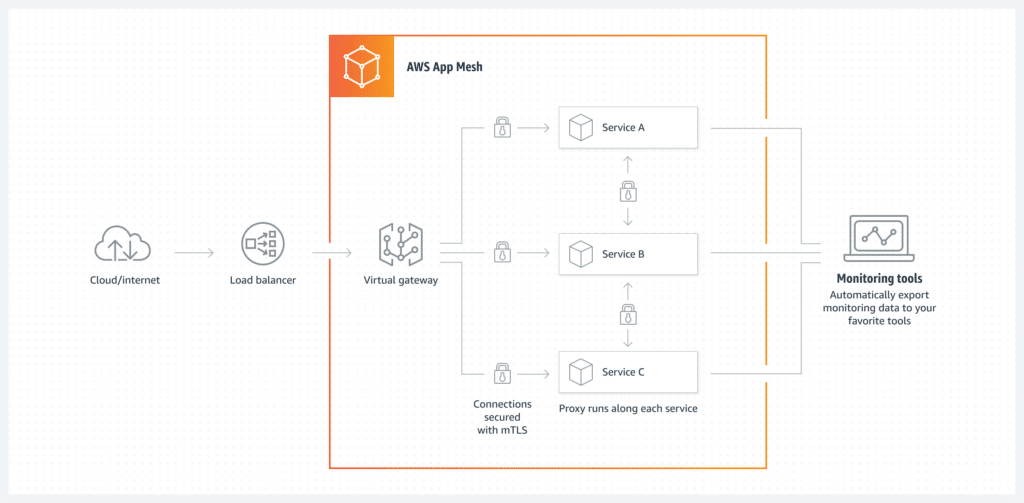Managing microservices efficiently and securely has become a paramount challenge for developers and organizations alike. AWS App Mesh emerges as a beacon of innovation, offering a powerful solution to streamline service-to-service communication in cloud-native applications. This comprehensive guide delves into the intricacies of AWS App Mesh, exploring its key features, components, and integration capabilities with the AWS ecosystem. Whether you’re looking to enhance traffic management, bolster security, or gain unparalleled observability into your microservices, AWS App Mesh provides the tools and flexibility needed to elevate your cloud strategy to new heights.
Table of Contents
Understanding AWS App Mesh
What is AWS App Mesh?
AWS App Mesh is a service mesh that facilitates easy and efficient communication between microservices, regardless of where they are deployed. It provides a robust framework to manage and control microservices in the cloud, offering features like traffic routing, security, and monitoring without requiring changes to application code.
How AWS App Mesh Works
At its core, AWS App Mesh uses the Envoy proxy, an open-source edge and service proxy designed for cloud-native applications. By implementing Envoy proxies alongside your services, App Mesh intercepts and manages all inbound and outbound service communications. This setup allows for detailed control and visibility over your microservices, enabling features such as precise traffic routing, health checks, and secure service-to-service encryption using TLS.

Key Features of AWS App Mesh
Simplified Service Communication
AWS App Mesh revolutionizes the way services communicate within a cloud-native application. It eliminates the need for custom networking code or third-party tools to manage service interactions. By abstracting the underlying complexity, App Mesh ensures that services can effortlessly discover and interact with each other, irrespective of their deployment environment. This seamless service discovery is facilitated through a service registry that dynamically tracks services within the mesh, enabling them to connect without hard-coded endpoints, thus enhancing scalability and flexibility.
Advanced Traffic Management
The traffic management capabilities of AWS App Mesh go beyond simple load balancing. It empowers developers with sophisticated routing rules and policies to control traffic flow between services. This includes:
- Canary Deployments: Gradually shift traffic to new service versions, allowing for testing in production with minimal risk.
- Blue/Green Deployments: Switch traffic between different service versions to ensure zero-downtime deployments.
- A/B Testing: Route traffic based on user identity or segment to test new features and functionalities.
These patterns can be implemented directly through the App Mesh console or API without altering your application code, making it easier to manage and iterate on your applications.
Enhanced Security
Securing service-to-service communication is critical. AWS App Mesh offers robust security features to safeguard your applications. Mutual TLS (mTLS) authentication is at the heart of App Mesh’s security model, ensuring that all traffic between services is encrypted and authenticated. This significantly mitigates the risk of unauthorized access and data breaches. Furthermore, App Mesh allows for fine-grained security policies, enabling you to dictate exactly which services can communicate, thereby enforcing the principle of least privilege.
Comprehensive Observability
Observability is a cornerstone of modern application development, providing insights into the health and performance of services. AWS App Mesh excels in this area by offering deep integration with AWS CloudWatch and AWS X-Ray. This integration provides a holistic view of your application’s operational health, including detailed metrics, logs, and traces. With App Mesh, you can:
- Monitor latency, error rates, and throughput across your services to identify performance bottlenecks.
- Trace request paths through your services to pinpoint failures or inefficiencies.
- Aggregate logs for a unified view of operational issues across your microservices architecture.
This level of observability is invaluable for maintaining high-performing, reliable applications and for making informed decisions based on real-time data.
Container Orchestration Native User Experience
AWS App Mesh is designed to seamlessly integrate with popular container orchestration platforms, including Amazon ECS, Amazon EKS, AWS Fargate, and Kubernetes running on EC2. This integration is manifested through the inclusion of the App Mesh proxy within the task or pod definitions of containerized workloads.
Such configuration ensures that application containers communicate directly through the proxy, which, upon service startup, automatically synchronizes with App Mesh for configuration and management. This seamless integration underscores App Mesh’s ability to provide a native user experience across diverse container orchestration environments, simplifying service management and enhancing operational efficiency.
Getting Started with AWS App Mesh
Setting Up AWS App Mesh
Embarking on your AWS App Mesh journey begins with creating a service mesh, a foundational step that encapsulates your microservices within a configurable network boundary. This process involves several key actions:
- Creating a Service Mesh: The initial step is to define your service mesh, which serves as the infrastructure layer facilitating service-to-service communication. This is done through the AWS Management Console or the AWS CLI, where you specify the mesh’s name and associated metadata.
- Defining Virtual Nodes: Each service in your application is represented as a virtual node within the mesh. A virtual node acts as a logical pointer to a backend service running on Amazon ECS, Amazon EKS, AWS Fargate, or directly on Amazon EC2 instances. Configuring virtual nodes involves specifying service discovery information, which allows services to locate and communicate with each other.
- Configuring Virtual Routers and Routes: Virtual routers manage traffic between your services, enabling you to direct requests based on application-specific rules. Routes within these routers determine how requests are distributed across the virtual nodes, supporting patterns such as canary and blue/green deployments. This setup allows for sophisticated traffic management strategies without modifying your service code.
- Applying Client-Side Traffic Policies: AWS App Mesh allows for the definition of client-side traffic policies that automatically manage load balancing and service health checks. These policies ensure that traffic is only directed to healthy service instances, enhancing the reliability and availability of your applications.
By following these steps, you can establish a robust service mesh that encapsulates your microservices, providing a unified layer for traffic management, security, and observability.
Integrating with AWS Ecosystem
AWS App Mesh’s strength lies in its deep integration with the AWS ecosystem, offering seamless interoperability with a variety of AWS services:
- Amazon ECS and AWS Fargate: App Mesh integrates directly with containerized services managed by Amazon ECS and serverless compute for containers with AWS Fargate. This integration simplifies the deployment of microservices by automatically injecting the Envoy proxy into your service containers, facilitating service discovery and secure communication.
- Amazon EKS: For Kubernetes users, App Mesh enhances the service mesh capabilities of Amazon EKS by providing a managed control plane that configures the Envoy sidecar proxies deployed with your Kubernetes pods. This allows you to leverage App Mesh’s features while maintaining the Kubernetes-native user experience.
- Amazon EC2: Applications running on EC2 instances can also benefit from App Mesh by manually or automatically deploying the Envoy proxy alongside your applications. This setup extends App Mesh’s traffic routing and security features to traditional compute workloads.
Through its comprehensive integration with these services, AWS App Mesh offers a flexible and powerful solution for managing microservices across different compute environments. Whether you are running containerized workloads on Amazon ECS, orchestrating services with Amazon EKS, or leveraging the scalability of AWS Fargate, App Mesh provides the tools to streamline service communication, enhance security, and improve observability across your applications.
AWS App Mesh Components
AWS App Mesh simplifies the networking and traffic management of microservices by introducing several core components that work together to create a flexible and powerful service mesh. Understanding these components is key to leveraging App Mesh effectively.
Service Mesh
At the heart of AWS App Mesh is the service mesh itself, a logical boundary that encapsulates the network traffic between the services within it. The service mesh serves as the central control plane, allowing you to define, manage, and control how services communicate with each other. It provides the foundation upon which all other App Mesh components interact, ensuring consistent policies and governance across your microservices architecture.
Virtual Services
Virtual services represent an abstraction layer over actual services, facilitating the decoupling of consumer and provider services within the mesh. A virtual service can route traffic to one or more virtual nodes directly or indirectly through a virtual router. This abstraction allows for greater flexibility in managing traffic policies, such as implementing canary deployments or service versioning without changing the service’s actual endpoint.
Virtual Nodes
Virtual nodes act as logical pointers to specific task groups, such as an Amazon ECS service or a Kubernetes deployment. When configuring a virtual node, you define the service discovery information, which allows App Mesh to route traffic to the underlying service instances correctly. Virtual nodes are essential for integrating your services with the mesh, enabling them to participate in the mesh’s traffic routing and policy enforcement.
Envoy Proxy
The Envoy proxy is a high-performance, open-source edge and service proxy that App Mesh uses to manage traffic flow between services. App Mesh can apply the defined traffic rules and policies at the application level by deploying the Envoy proxy alongside your service instances. This setup allows for sophisticated traffic management capabilities, such as dynamic routing, fault injection, and traffic shaping, all without requiring changes to the application code.
Virtual Routers
Virtual routers manage the routing of traffic between different virtual services within the mesh. They work in conjunction with routes to make decisions on how traffic should be directed based on predefined rules. Virtual routers enable you to implement complex routing logic, ensuring that requests are handled efficiently and reliably.
Routes
Routes are associated with virtual routers and define the rules for routing traffic to various virtual nodes based on criteria such as service name prefixes, HTTP headers, or URL paths. By defining routes, you can control the flow of traffic within your mesh, directing it to the appropriate service versions or endpoints based on your specific requirements.
Together, these components form the backbone of AWS App Mesh, providing a comprehensive solution for managing microservice communications. By abstracting the complexity of service-to-service networking, App Mesh allows developers to focus on building and scaling their applications, secure in the knowledge that their services are communicating efficiently, securely, and reliably.
Use Cases for AWS App Mesh
Microservices Communication
AWS App Mesh excels in environments where microservices need to communicate across different compute types. It provides a unified layer to manage service discovery, traffic routing, and security policies, making it easier to maintain and scale complex applications.
Application Resiliency
By leveraging AWS App Mesh’s traffic routing rules, you can improve the resiliency of your applications. Features like automatic retries, circuit breaking, and rate limiting help ensure that your services remain available and responsive, even in the face of failures.
Secure Service Architecture
With its built-in support for mTLS, AWS App Mesh is an ideal solution for securing service-to-service communication. It ensures that your services can only be accessed by trusted entities, providing a strong foundation for building secure cloud-native applications.
Conclusion
AWS App Mesh represents a significant advancement in the way microservices are managed and operated in the cloud. By abstracting the complexity of service-to-service communication, it allows developers to focus on building business logic rather than infrastructure management. Whether you are looking to simplify service discovery, manage traffic flow, enhance security, or gain better visibility into your applications, AWS App Mesh offers a comprehensive set of tools to achieve these goals.
For organizations looking to adopt a service mesh, AWS App Mesh provides a powerful, flexible, and secure option that integrates seamlessly with the broader AWS ecosystem. As cloud architectures continue to evolve, tools like AWS App Mesh will play a critical role in enabling the next generation of scalable, resilient, and secure applications.
Additional Resources
- AWS App Mesh Pricing (Understand the cost implications of implementing AWS App Mesh in your architecture.)
- AWS App Mesh User Guide: Meshes (Dive deeper into the concept of service meshes and how they function within AWS App Mesh.)
- Getting Started with AWS App Mesh (Kickstart your journey with AWS App Mesh with this comprehensive getting-started guide.)




